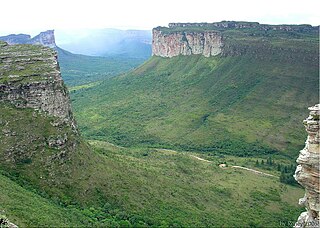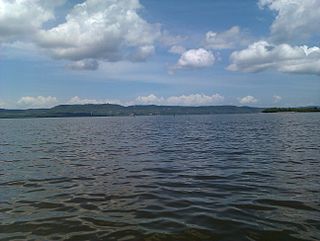Location
The Boa Nova National Park covers parts of the municipalities of Boa Nova, Dário Meira and Manoel Vitorino in Bahia. The park has an area of 12,065.31 hectares (29,814.0 acres). The terrain is rugged with altitudes from 440 to 1,111 metres (1,444 to 3,645 ft) above sea level. The park drains into the Uruba River, a tributary of the Gongogi River, which in turn is a tributary of the de Contas River.
The park is in the Atlantic Forest biome. Average annual rainfall is 1,300 millimetres (51 in). Temperatures range from 14 to 26 °C (57 to 79 °F) with an average of 23 °C (73 °F). Vegetation includes caatinga, semi-deciduous submontane forest, montane rainforest and semi-deciduous lowland forest. The region is well known for the many species of birds, with 437 recorded to date, which attract many foreign birdwatchers. Endemic bird species include the endangered or threatened slender antbird (Rhopornis ardesiacus), Bahia spinetail (Synallaxis whitneyi) and Bahia tyrannulet (Phylloscartes beckeri).

The Chapada Diamantina National Park is a national park in the Chapada Diamantina region of the State of Bahia, Brazil. The terrain is rugged, and mainly covered by flora of the Caatinga biome.
Pau Brasil National Park is a national park in the state of Bahia, Brazil. It preserves a remnant of the Atlantic Forest biome.

Una Biological Reserve is a Biological reserve in Brazil.
Córrego do Veado Biological Reserve is a biological reserve in the municipality of Pinheiros, Espírito Santo, Brazil.
Augusto Ruschi Biological Reserve is a Federal biological reserve in the state of Espírito Santo, Brazil. It holds dense rainforest of the Atlantic Forest biome.

Sooretama Biological Reserve (Portuguese: Reserva Biológica de Sooretama is a biological reserve in the state of Espírito Santo, Brazil.
Córrego Grande Biological Reserve is a biological reserve spanning the boundary of Bahia and Espírito Santo, Brazil.

Monte Pascoal National Park is a national park in the state of Bahia, Brazil.

The Descobrimento National Park is a national park in the state of Bahia, Brazil.
The Serra das Lontras National Park (Portuguese: Parque Nacional da Serra das Lontras is a national park in the state of Bahia, Brazil. It protects a rugged area of Atlantic Rainforest with a wide range of bird species, including several that are threatened with extinction.

Alto Cariri National Park is a national park in Brazil.

Serra do Gandarela National Park is a national park in the state of Minas Gerais, Brazil. It protects a mountainous region holding a remnant of Atlantic Forest that is an important source of water for the city of Belo Horizonte.

The Guaricana National Park is a national park in the state of Paraná, Brazil. It protects a mountainous area holding a remnant of Atlantic Forest.
The Cassurubá Extractive Reserve is an extractive reserve in the state of Bahia, Brazil.

The Baía do Iguape Marine Extractive Reserve is a marine extractive reserve in the state of Bahia, Brazil. As of 2002 the reserve supported about 5,000 people engaged in fishing and shellfish collection.
The Canavieiras Extractive Reserve is a coastal marine extractive reserve in the state of Bahia, Brazil.

The Rio dos Frades Wildlife Refuge is a wildlife refuge in the state of Bahia, Brazil. It protects the land around the mouth of the Frades River. There is pressure, or opportunity, to develop the reserve for tourism.
The Boa Nova Wildlife Refuge is a wildlife reserve in the state of Bahia, Brazil.
The Santa Cruz Wildlife Refuge is a wildlife refuge in the state of Espírito Santo, Brazil.

The Costa das Algas Environmental Protection Area is an environmental protection area in the state of Espírito Santo, Brazil.
This page is based on this
Wikipedia article Text is available under the
CC BY-SA 4.0 license; additional terms may apply.
Images, videos and audio are available under their respective licenses.











